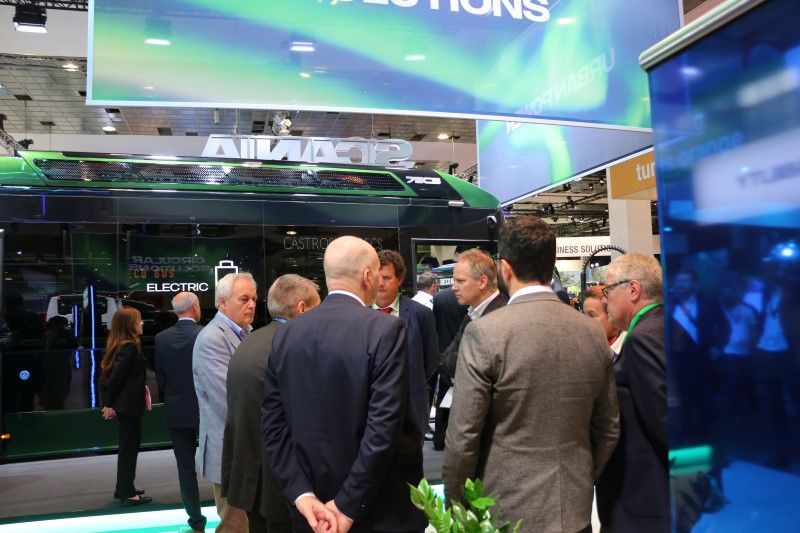Crashworthiness of buses – a matter of life, death and labour rights
Speech/statement | Date: 10/10/2023 | Ministry of Transport
Comment from the Norwegian Minister of Transport, Jon-Ivar Nygård, in Euractiv October 10. 2023.
Accident investigations show unacceptable risk for bus drivers on an everyday basis. Low-speed crashes may cause fatal injuries. How long should drivers risk their lives for public transport?

Minister of Transport, Jon-Ivar Nygård, at Bus World October 10. Photo: Mission of Norway to the EU.
Over the past years, several fatal accidents involving bus drivers in Norway have occurred. Accident investigations have revealed that the frontal construction of the buses involved offered little protection in head-on collisions, even though the buses complied with national and European regulations.
One of the accidents happened in 2019, involving two buses in a head-on collision. Despite low speed (34 km/h), the accident was fatal for one of the drivers. The other driver was severely injured.
The report from Accident Investigation Board Norway (AIBN) on the accident is available in English.
Call for harmonized safety standards
While there are numerous mandatory and non-mandatory safety standards for the protection of driver and passengers in cars and trucks, there are no safety standard particularly developed for the front protection of buses.
As a result, bus drivers go to work risking their lives every day. In the event of a head-on collision, they are left largely unprotected.
The lack of available safety standards applies to all types of buses. The illustration below shows the insufficient regulations available or mandatory for buses, compared to trucks and passenger cars.
The figure illustrates the most relevant UNECE regulations for collision protection on urban buses (bus categories 1 and 2), express coaches (bus category 3), trucks and passenger cars.
In a safe system approach, I consider the lack of collision protection of bus drivers a considerable deficiency which should be addressed at European level.
Pursuing the Vision Zero, developing a safety standard for front protection of buses should be an achievable and prioritized task. European car manufacturers and authorities has led the way for safer cars. Now is the time for buses.
European regulations for crashworthiness standards largely rely on the safety provisions developed in within the frameworks of the United Nations’ World Forum for Harmonization of Vehicle Regulations (WP.29).
In Europe, there are currently around twenty major manufacturers of buses. Several manufacturers have taken steps to go further than the regulatory requirements and installed collision protection on some of their bus models by using the same regulations as for heavy goods vehicles, even though they are not ideal solutions for buses (the yellow markings in the illustration are such features).
Thousands of European buses constructed to these requirements are being used in public transport, private charters and tourism every day. These buses are working places. On behalf of the thousands of European bus drivers, their families and communities, we should take action to phase out buses with insufficient collision protection.
A harmonized safety standard for front protection of buses will make it easier for the front-runners in safety improvements to move forward and improve the safety of buses.
A voluntary safety standard would provide considerable safety benefits – but the full safety benefits will only be reached if it is a requirement in all new buses.
Norwegian ambition
The AIBN have studied a series of accidents involving buses and presented safety recommendations to take action nationally and internationally to improve the legal safety requirements for buses.
We have been left with no choice but to act. Taking effect from October 1 this year, a new national regulation requiring every new bus in licensed transport in Norway, in all categories, to meet stricter requirements for front collision protection (UNECE Regulation no. 29 (R-29)).
The standard is already a requirement in most public tenders for bus transport in Norway. The national regulation is developed in close cooperation with Norwegian bus and transport companies, trade unions representing both drivers and their employers and the municipal companies responsible for public transport.
We consider establishing R-29 requirements is a necessary first step, but an insufficient measure. R-29 is developed for trucks and is only partly suitable for buses, and does not offer sufficient safety level for crashworthiness.
The best way forward is by working together in Europe in developing harmonized safety standards.
Representatives from the Norwegian bus industry are organising the Driver Safety Seminar at Bus World Europe on 10 October. I will be there to talk about the need for a harmonised safety standard. We will also launch a guiding report for decision-makers on road safety measures for bus transport by the Norwegian Institute of Transport Economics.
I believe road safety is not a personal matter. Road safety concerns us all, including the safety of our much needed bus drivers.